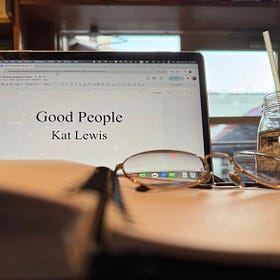Your Antagonist Will Make Or Break Your Story
Three Steps for Building a Bad Guy
Learning Objective: By the end of this post, you will know how to develop your story’s ordinary world, inciting incident, and antagonist to create compelling conflict.
In our last craft lesson, we did a deep dive into the five components of a revenge plot. The most important component of a revenge plot is a good bad guy. But any story, regardless of its genre or age category greatly benefits from an antagonist that ceaselessly challenges the protagonist until they emotionally grow to solve the problem at hand. This week’s post is all about developing conflict that will help your story (and its bad guy!) stand out in a slush pile. Today, we’re breaking down three key craft elements that create propulsive conflict. This craft lesson was originally sent out to our early subscribers in 2022, and it quickly became one of the most popular posts in our archive. If you’ve ever struggled with creating the kind of conflict that makes a story unput-downable, this post is for you.
As always, you know what to do: take anything that’s useful to you and your writing life and leave everything that’s not behind.
Why Antagonists Matter
A story is only as good as its bad guy.
This is an adage I deeply believe in as a Marvel fan. The best superhero stories have compelling villains with concrete goals that are in direct opposition with the protagonist’s goals. This is why I loved WandaVision. The stakes feel so high as the S.W.O.R.D. agents attempt to dismantle Wanda’s alternate reality to save the residents of Westview.
This adage is also why I hated The Falcon and the Winter Soldier. Every scene with Karli, the main antagonist, annoyed me because I didn’t fully understand the four elements of her character goals or how her goals were directly in opposition with Sam and Bucky’s. Since the antagonist’s goals and motivations were vague and abstract, I wasn’t invested in the show in the same way that I was invested in WandaVision.
A Guide to Developing Character Desire
Learning Objective: By the end of this post, you will know how to develop your character’s goals with four guiding questions.
Now, I’m not trying to start any beef with diehard Falcon and Winter Soldier fans. All I’m saying is that these two shows are examples—for me—of how a story is only as good as its bad guy.
While I deeply believe in this saying as a Marvel fan, it took a long time for me to embody it in my writing practice as a literary fiction writer. Until I read The Story Solution by Eric Edson, I didn’t believe that a literary novel had to have person vs. person conflict to be effective, and there are, of course, plenty of examples of quiet novels that do not make use of this western storytelling convention.
But if your ultimate goal is to sell a book to a western publisher, adding a strong person vs. person conflict will always make a story more effective and more marketable.
When I was a new literary fiction writer, I was resistant to person vs. person conflict because I associated the word “antagonist” too much with genre fiction. I’d hear the word and think “bad guy” or “supervillain,” both things I love in Marvel movies but wasn’t interested in exploring in my own writing.
My outlook changed when I read The Story Solution because Edson framed antagonism in a new way. In his book, he says that conflict is king, and an “opposing force character” is necessary to create conflict.
Before reading this book, I had a misconception that an antagonist was an artificial force added to rotely drive a story forward. But Edson’s book frames the antagonist as an adversary—not a character that exists for the sole purpose of foiling the protagonist’s efforts, but a character who exists and has their own goals and desires independent of the protagonist. The adversary is just unlucky because their goals happen to interfere with the protagonist’s.
Once you’ve fleshed out your protagonist’s goals with our lesson on character desire, it’s time to create your conflict by developing three key aspects of your story:
Ordinary World
Inciting Incident
Antagonist
This week, we’ll be looking at Black Panther (2018) and “The Era1” by Nana Kwame Adjei-Brenyah as examples. Spoilers ahead for both of these stories.
Developing Conflict
1. Ordinary World
The ordinary world is what the protagonist’s life looked like before the start of the story. Stories are most effective when the protagonist begins in a Broken Place, which consists of the problems that the protagonist has before the story even starts. Some stories will have two broken places: one that’s specific and personal to the character and another that’s universal to everyone in the story world.
Guiding Questions:


